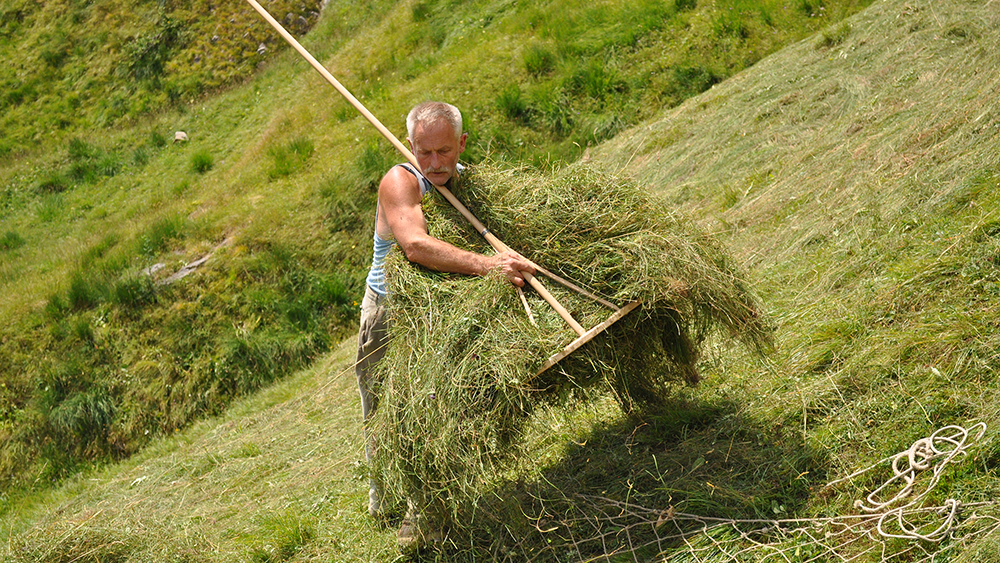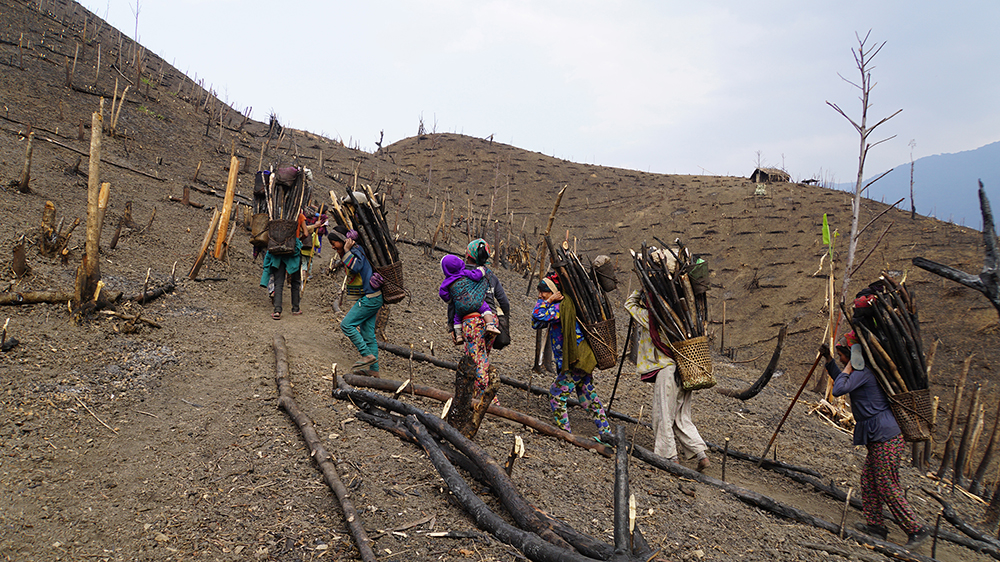Of Scythes, Scythe Hammers and Work Songs
Working on steep slopes places much greater demands on the human body than working on level ground. Just standing on a steep mountainside requires sustained strength in the legs and a strong sense of balance. Given the dangerous terrain and weather-related time constraints, agricultural workers need exceptional concentration skills, an accurate understanding of the environment, the ability to move their bodies efficiently – and the right tools.
The exhibition in the Ethnographic Museum focuses on the work tools used for both wild hay making in the Alps and shifting cultivation in the Himalayas. On display are scythes from various regions of Switzerland, whetting and sharpening equipment, rope woods for tying hay bales, as well as cloths, nets and sleds for transportation. The Asian counterparts include panniers, dibbles, hoes, sickles and rain shields made of plant fibers, plus tea containers and opium cans that were used for rest breaks in the field huts.
The tool makes the man
The exhibited equipment has to fulfill many requirements with respect to its work purpose, the material to be processed, special features of the work site and the preferences of its makers. “Each tool is a distillation of extensive knowledge and experience,” says curator Rebekka Sutter. “As such, it tells us something about the people that use it and the environment in which it is used.” For example, the blade of a scythe used for mowing steeply sloping rough pasture is shorter and narrower than that of a scythe used for mowing thick grass on lowland plains.
However, just because a tool is technically sophisticated does not guarantee that it will be used efficiently. Even with a freshly sharpened scythe, a beginner will not be able to cut with a clean sweep. An experienced mountain farmer, on the other hand, knows how to unite body, tools and environment in the rhythm of his work. “It’s only then,” says scythe maker Hansjörg von Känel, who speaks every so often at the exhibition, “that the mower is no longer leading the scythe, but the scythe is leading the mower.” Or, as the French agronomist and historian François Sigaut would put it: “L’outil fait l’homme” – the tool makes the man.
Sights and sounds of an unusual living environment
It’s not only the objects in the exhibition that bear witness to the unique working conditions on steep slopes, but also the soundscape in which they are anchored. In this soundscape, toolmakers, peasant women and mowers make observations and tell stories and jokes about their activities and everyday life on steep hillside terrains. Between these tales, typical work sounds, songs of Southeast Asian field workers and the prayer calls of alpine herdsmen can be heard. “Objects and sounds are inextricably linked in the exhibition, as they are in everyday life,” says curator Thomas Kaiser. “Together, they portray the steep mountainsides as a living and working space in which people create, reflect on and celebrate their environment.”

Wild hay making in the Alps
“Wild hay” is the hay produced on alpine pastures that are too steep and exposed for livestock. The grassy slopes are only used for agriculture by corporations, alp owners or tenants during the summer grazing season. Until the mid-20th century, wild hay making was an integral part of alpine farming. Thanks to this additional supply of dry feed, mountain farmers were able to sustain their animals through the winter. Nowadays, the Swiss government supports wild hay making because of its role in maintaining biodiversity and preserving intangible cultural heritage. It is also important for preventing erosion and landslides. (Image: Sabine Weiss, 2018)

Shifting cultivation in the Himalayas
While irrigation farming prevails on the Southeast Asian plains, shifting cultivation – or slash-and-burn cultivation – has, until recently, dominated the mountain regions of the Himalayas. This farming method involves the cutting and burning of above-ground vegetation, leaving the root system intact. The arable land this creates is farmed for two to three years and then left to lie fallow until the natural vegetation has recovered. In the past, this cycle could take over twenty years to complete. Today, in many places, population growth and financial considerations have shortened this time period to just a few years. The effects of this are deforestation and erosion, leading to a tightening of rules and even national bans on this method of cultivation. (Image: Rebekka Sutter, 2017).